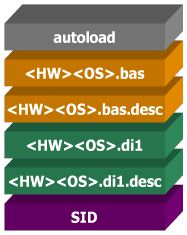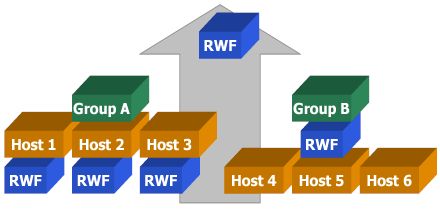|
 The
image on left illustrates
The Rembo Wizard's file
name diagram, referred as RWF later in this document and presented
with a blue block illustrated on the right The
image on left illustrates
The Rembo Wizard's file
name diagram, referred as RWF later in this document and presented
with a blue block illustrated on the right . .
autoload is the file containing configuration information.
<HW><OS>.bas is the operating system installation's base image,
desc being a text file containing a description. If the base image is very
large, the file may be spit into several files on the Rembo Server,
depending of its settings. Starting from Rembo 2.0 version, the file does not
contain the actual contents of the disk but it is rather an index to the files
in it. The actual files are stored elsewhere in the Rembo file system.
Note: Deleting the image file does not delete the actual files stored in the
Rembo file system, you must use server's specific command options to delete
orphan files. Please see Rembo server's documentation.
<HW><OS>.di1 is the first differential, or incremental image, compared to the base
image. There can be up to nine differential images (di1, di2, ... di9)
according to the settings in the configuration.
<HW><OS>.si1 (not illustrated) is the first system
snapshot image. A snapshot image is comparable to the base image, only that it
is named differently. Also it can be taken by the user while the base image can
be taken only by the administrator. System snapshot can be taken only if a base
image exists.
The Rembo Wizard uses
Rembo's caching techniques so that the creation and restoration times of the
system snapshot images are considerable faster than those of the base image. There can be
up to nine system snapshot images (si1, si2, ... si9) according to the
settings in the configuration.
SID stores at host level a unique system identifier for Windows
NT/2000/XP systems.
BootSector, and some other files may be attributed at host level to
systems with unattended and automatic reparation features.
<HW> is a three capital letter identifier chosen by the
administrator for the target computer, while
<OS> is a three capital letter identifier that must be set
according to target's
operating system. See configuration chapter.
The Rembo Wizard follows
Rembo's host -> group -> global search hierarchy when it localizes the file
positions.

In the above example, Group A of computers is configured each to have their
own, individual back-up scheme. Group can contain different hardware and
operating system configurations.
Note: when using cloning techniques you would create a base image
in the global or in the group level. In the case of the example Group A of
machines you would like to
- Extract the base image from the Rembo File system for backup and
distribution purposes.
- Move or copy the base image under each target host's scope level before
taking any differential images (if you leave the base image to the group
level, all differential images will end up into that level, from all hosts!).
- Remove the base image from the group level if there is no more cloning
based installations to do.
Group B is configured to produce identical systems (clones) from a grouped
system image.
It is very rare that an host would need
The Rembo Wizard files
from the global level, which is rather a system administrator's repository.
For obvious practical reasons, when looking at the Rembo Server's file system
with the Rembo Management Console, the group directories and host directories
(based on the MAC address of each host) are presented on the same level.
 This
picture shows how target host's autoload and SID files are located
in the Rembo Server's file system. This
picture shows how target host's autoload and SID files are located
in the Rembo Server's file system.
 Target
host's base images and differential images are located under hdimages-directory.
It is worthwhile to note that
The Rembo Wizard does not
use subdirectories for each operating system type, although they can be created
by some other Rembo wizards. The operating system type is contained in the
image's file name. Target
host's base images and differential images are located under hdimages-directory.
It is worthwhile to note that
The Rembo Wizard does not
use subdirectories for each operating system type, although they can be created
by some other Rembo wizards. The operating system type is contained in the
image's file name.
autoload-file exists at all levels. Certain number of configuration
values must be set for all target systems. They are usually set and modified
using the
The Rembo Wizard's
configuration dialog. But there exists other configuration settings that are not
necessarily present at the host level. If not found from the group level
autoload-file, they are taken from the global level autoload-file,
which contains default values for all settings. A value not present in the host
level autoload-file can be copied from the global level autoload-file
and the default value modified.
26 Mar 2003
|